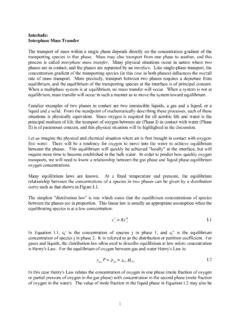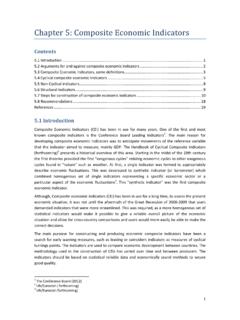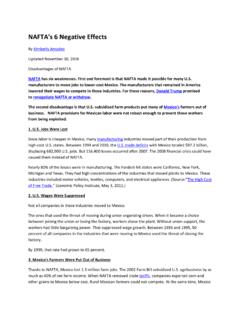Transcription of Incorporating the Impact of Engineering Solutions on ...
1 Global Journal of Engineering Education 2005 UICEE 1 INTRODUCTION Engineering Solutions have always had a major Impact on society. In some cases this Impact has been clearly positive, such as in the case of house appliances and water purification. In others the Impact has been negative, as in the case of bombs with ever-increasing destructive power. In many some cases the Impact of Engineering products has been both positive and negative, as in the case of the automobile. Engineers usually give the proper attention to the safety and cost of their products, two aspects that Impact all users of Engineering products and therefore society as a whole.
2 More recently, engineers have also become more sensitive regarding the environmental Impact of their products. On the other hand, there have been many cases where the engineers involved in the creation of a particular solution, constrained with a limited view of the situation they were trying to address, were not aware or could not possibly imagine the Impact their product would later have on the society as a whole (for example, CFC s which caused destruction of the ozone layer). In the era of market and work-force globalization engineers need to have a solid understanding of the Impact their products will have locally as well as globally so they can make a sound evaluation of the pros and cons . The American Society for Engineering Education expresses the need for this global and societal perspective as follows: [E]ngineering colleges must not only provide their graduates with intellectual development and superb technical capabilities, but, following industry s lead, [they] must educate their students to work as part of teams, communicate well, and understand the economic, social, environmental, and international context of their professional activities.
3 [1]. Moreover, the US Accreditation Board for Engineering and Technology (ABET) recently put a new spin on this requirement in Engineering education. Specifically, outcome 3h of Engineering Criteria 2000 states that Engineering programs must demonstrate their graduates have the broad education to understand the Impact of Engineering Solutions in a global / societal context [2]. This outcome may be one of the most difficult to truly achieve since it requires not only a strong technical understanding but also an informed societal and historical perspective that is particularly difficult to achieve in curricula with few liberal arts courses. There are numerous examples of Engineering projects that have a major effect on society that illustrate this need. For example, students may work on the design of a dam to provide hydroelectric power.
4 While hydroelectric power results in no pollution or greenhouse gas emissions, students must be encouraged to examine the greater environmental and social ramifications of creating a new dam in a community. For example, people may be displaced and farmland and cultural sites flooded. Negative environmental impacts may include ponding and eutrophication, and the fish population may be adversely affected. On the other hand, new dams may help control flooding. Many articles have recently been published about the expected positive and negative effects of the Three Gorges Dam project on the Yangtze River in China, which is displacing over a million people (See for example [3].) HOW CAN Engineering PROGRAMS INCORPORATE GLOBAL AND SOCIETAL PERSPECTIVES IN THEIR CURRICULA?
5 Universities seek to instil these global and societal perspectives into their students through a variety of methods. Worcester Polytechnic Institute has a project-based curriculum. Students must complete three large projects, and 60% of the students complete a project off campus, most often in an international setting. [4] Engineering students at Messiah College may work Incorporating the Impact of Engineering Solutions on Society into Technical Engineering Courses Nicole DeJong Okamoto, Jinny Rhee, Nikos J. Mourtos Department of Mechanical and Aerospace Engineering San Jose State University San Jose, USA ABSTRACT In the era of market and work-force globalization engineers need a solid understanding of the Impact their products have locally as well as globally. This is why the US Accreditation Board for Engineering and Technology recently put a new spin on this requirement in Engineering education.
6 Specifically, outcome 3h of Engineering Criteria 2000 states that Engineering graduates must have the broad education to understand the Impact of Engineering Solutions in a global / societal context . This outcome may be one of the most difficult to achieve since it requires not only a strong technical understanding but also an informed societal and historical perspective that is particularly difficult to achieve. This paper identifies some of the skills students need to be able to evaluate the Impact of their Solutions in a global / societal context as well as methods used by some universities to address this issue outside of technical Engineering courses. The main focus of this paper is the introduction of course design elements that help students master these skills that can be incorporated into required and elective Engineering courses.
7 Examples are presented from a variety of thermal/fluid courses where these skills are taught in the Mechanical and Aerospace Engineering Department at San Jose State University. 2on a multi-disciplinary team to complete a culturally-appropriate international Engineering project. For example, in their water purification project, students from a variety of disciplines work with a local water company to develop innovative, economical water purification systems for impoverished communities. [5] Students at Calvin College can take a one-month interim course during January. Many of these courses are offered in foreign countries. Some Engineering students take the course Design for the International Market which is held in several Western European countries.
8 Students desired course outcomes include discerning cultural differences, cultivating interests in non-technical fields, improving critical thinking, and increasing understanding of global markets. [6] The College of Engineering at San Jose State University has established a one-million-dollar Global Technology Initiative, whose mission is to give American students a global perspective with a focus on technology and business developments in the Asia-Pacific region. The donors of the initiative are business leaders in the high-technology industry with strong business ties in the Silicon Valley and the Asia-Pacific region. In the inaugural program in 2004, twenty-five students and four faculty members visited a variety of industrial, academic, and cultural sites in China and Taiwan.
9 A second program is planned for 2005. [7] WHAT KINDS OF SKILLS ARE NEEDED TO EVALUATE THE Impact OF Engineering Solutions IN A GLOBAL / SOCIETAL CONTEXT? The first task in the design of a curriculum that gives students the broad education to understand the Impact of Engineering Solutions in a global / societal context is a more precise definition of this understanding. A faculty discussion in the Mechanical and Aerospace Engineering Department at San Jose State University concluded that students have the kind of understanding described in outcome 3h if they are able to do the following: 1. Evaluate and describe accurately the environmental Impact of aerospace / mechanical Engineering products, including those they have designed in course projects. 2. Evaluate and describe accurately environmental and economic tradeoffs in aerospace / mechanical Engineering products, including those they have designed in course projects.
10 3. Evaluate and describe accurately the health / safety and economic tradeoffs in aerospace / mechanical Engineering products, including those they have designed in course projects. 4. Take into consideration the environmental Impact when designing aerospace / mechanical Engineering products. 5. Take into consideration the health / safety Impact when designing aerospace / mechanical Engineering products. 6. Speculate on large-scale societal changes that some Engineering innovations may cause. Although this list of skills is by no means exhaustive, it forms a good foundation upon which our faculty could build course elements to address outcome 3h. COURSE DESIGN ELEMENTS TO ENHANCE UNDERSTANDING OF THE Impact OF Engineering Solutions IN A GLOBAL / SOCIETAL CONTEXT In order for students to thrive in the highly competitive global economy, it is critical for them to develop international perspectives and knowledge.








